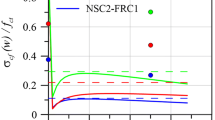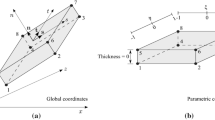Abstract
The mechanical behavior of steel fiber reinforced concrete (SFRC) is strongly dependent on the cracks bridging brought by fibers. Thus, the fibers orientation in SFRC is one key factor. This research extends a micromechanics-based model to describe the shear transfer in addition to tensile mechanisms at the crack surface and to establish a base at micro-scale for the further homogenization at the macro-scale. The shear effect is described as a function of the fiber pullout process, the stress across the cracks is then derived from the integration of the product of the fiber pullout function by the probability of the fiber location and orientation. The simulation results provide the SFRC behavior under mixed-mode displacement of crack (slip and opening). The influence of material parameters is investigated.
Access this chapter
Tax calculation will be finalised at checkout
Purchases are for personal use only
Similar content being viewed by others
References
Resplendino, J., Toutlemonde, F.: Designing and Building with UHPFRC. Wiley, Hoboken (2011)
Rossi, P.: Les bétons de fibres métalliques. Presses De L’ENPC (1998)
Casanova, P.: Bétons renforcés de fibres métalliques: du matériau à la structure. Etude expérimentale et analyse du comportement de poutres soumises à la flexion et à l’effort tranchant. Ph.D. thesis, Ecole Nationale des Ponts et Chaussées (1995)
Khaloo, A.R., Kim, N.: Influence of concrete and fiber characteristics on behavior of steel fiber reinforced concrete under direct shear. Mater. J. 94(6), 592–601 (1997)
Kaufmann, W., Amin, A., Beck, A., Lee, M.: Shear transfer across cracks in steel fibre reinforced concrete. Eng. Struct. 186, 508–524 (2019)
Herrera, A.: Fonctionnement des jonctions âmes-membrures en Béton Fibrés à Ultra-Hautes Performances (BFUP). Ph.D. thesis, Université Paris-Est (2017)
Morton, J., Groves, G.W.: The cracking of composites consisting of discontinuous ductile fibres in a brittle matrix—effect of fibre orientation. J. Mater. Sci. 9(9), 1436–1445 (1974)
Chanvillard, G.: Analyse expérimentale et modélisation micromécanique du comportement des fibres d’acier tréfilées, ancrées dans une matrice cimentaire, vol. OA12. LCPC (1992)
Lee, G., Foster, S.: Behaviour of Steel Fibre Reinforced Mortar in Shear I: Direct Shear Testing, University of New South Wales Concrete Testing Laboratory, Scientific UNICIV No. R-444, October 2006
Foster, S.J., Lee, G.G., Htut, T.N.S.: Radiographic imaging for the observation of Modes I and II fracture in Fibre Reinforced Concrete. In: Proceedings of the FraMCos6, vol. 3, pp. 1457–1465, June 2007
Htut, T.N.S., Foster, S.J.: Unified model for mixed mode fracture of steel fibre reinforced concrete, p. 9 (2010)
Li, V.C., Wang, Y., Backer, S.: A micromechanical model of tension-softening and bridging toughening of short random fiber reinforced brittle matrix composites. J. Mech. Phys. Solids 39(5), 607–625 (1991)
Wu, C., Leung, C.K.Y., Li, V.C.: Derivation of crack bridging stresses in engineered cementitious composites under combined opening and shear displacements. Cem. Concr. Res. 107, 253–263 (2018)
Guenet, T.: Modélisation du comportement des bétons fibrés à ultra-hautes performances par la micromécanique: effet de l’orientation des fibres à l’échelle de la structure. Ph.D. thesis, Université Paris-Est, Université Laval (2016)
NF P18-710. Complément national à l’Eurocode 2 - Calcul des structures en béton : règles spécifiques pour les bétons fibrés à ultra-hautes performances (BFUP). AFNOR (2016)
NF P18-470. Bétons fibrés à ultra hautes performances - Spécification, performance, production et conformité. AFNOR (2016)
fib Model Code for Concrete Structures 2010. Ernst & Sohn (2013)
Katz, A., Li, V.C.: Inclination angle effect of carbon fibers in cementitious composites. J. Eng. Mech. 121(12), 1340–1348 (1995)
Naaman, A.E., Shah, S.P.: Pull-out mechanism in steel fiber-reinforced concrete, vol. 102. American Society of Civil Engineers ASCE (1976)
Alwan, J., Naaman, A.E., Guerrero, P.: Effect of mechanical clamping on the pull-out response of hooked steel fibers embedded in cementitious matrices. Concr. Sci. Eng. 1(1), 15–25 (1999)
Robins, P., Austin, S., Jones, P.: Pull-out behaviour of hooked steel fibres. Mater. Struct. 35(7), 434–442 (2002)
Timoshenko, S.: Strength of Materials. Part 1: Elementary Theory and Problems. D. Van Nostrand Company, Incorporated (1940)
Leung, C.K.Y., Li, V.C.: Effect of fiber inclination on crack bridging stress in brittle fiber reinforced brittle matrix composites. J. Mech. Phys. Solids 40(6), 1333–1362 (1992)
Li, B., Maekawa, K., Okamura, H.: Contact density model for stress transfer across cracks in concrete. J. Fac. Eng. Univ. Tokyo 40, 9–52 (1989)
Author information
Authors and Affiliations
Corresponding author
Editor information
Editors and Affiliations
Rights and permissions
Copyright information
© 2022 RILEM
About this paper
Cite this paper
Vu, DT., Toutlemonde, F., Terrade, B., Marchand, P., Bouteille, S. (2022). Numerical Modeling of the Steel Fiber Reinforced Concrete Behavior Under Combined Tensile and Shear Loading by a Micromechanical Model Taking into Account Fiber Orientation. In: Serna, P., Llano-Torre, A., Martí-Vargas, J.R., Navarro-Gregori, J. (eds) Fibre Reinforced Concrete: Improvements and Innovations II. BEFIB 2021. RILEM Bookseries, vol 36. Springer, Cham. https://doi.org/10.1007/978-3-030-83719-8_39
Download citation
DOI: https://doi.org/10.1007/978-3-030-83719-8_39
Published:
Publisher Name: Springer, Cham
Print ISBN: 978-3-030-83718-1
Online ISBN: 978-3-030-83719-8
eBook Packages: EngineeringEngineering (R0)




